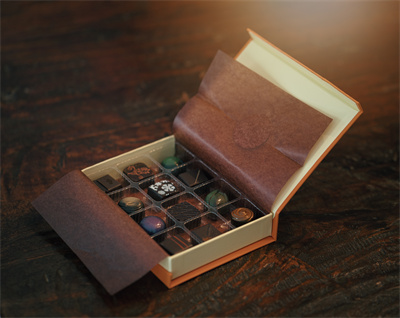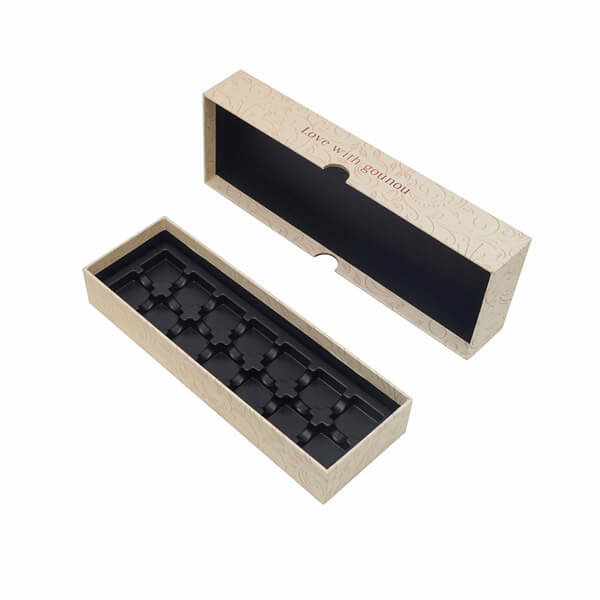Contact Us

Contact Us


Guangzhou Huaisheng Packaging Co.,Ltd.
We provide customers with quality products and provide high-quality services.
If you would like to leave us a comment please go to contact us
+86-18122240089

Chocolate, a delicious food, has captivated the hearts and palates of countless connoisseurs around the globe. According to forecasts from agencies, global chocolate consumption is expected to be 7.5 million tons in 2023.
The importance of packaging for chocolate cannot be overstated—it is the guardian of the chocolate's integrity from the moment it leaves the confectioner until it melts in the consumer's mouth. In this article, we'll explore the intricacies of choosing the ideal packaging for chocolate, ensuring that each bite is as impeccable as the confectioner intended.
Protection against environmental factors is paramount in chocolate packaging. Heat, light, and moisture are the adversaries of chocolate, capable of degrading its quality through melting, blooming, and loss of texture. A well-designed package serves as a barrier, shielding the chocolate from temperature fluctuations and humidity, which can prove disastrous.
No one wants to eat spoiled chocolates, so preservation of flavor and texture is important too. Chocolate's delicate flavors can be tainted by external odors, while its texture, a critical component of the tasting experience, is preserved by preventing exposure to air that can cause oxidation and staleness.
The impact on shelf life is a direct result of effective packaging. By protecting the chocolate from environmental threats and contamination, the packaging extends the product's shelf life, ensuring that consumers experience the chocolate as intended, regardless of the time elapsed since production.

There are many traditional packaging materials for chocolate, such as paper, foil, and plastic. Paper is a classic packaging material with good printing properties, foil is celebrated for its ability to block light and air, and plastic provides a versatile and often transparent option, allowing consumers to see the product before purchase.
Innovative materials are on the rise, giving chocolate brands more options. Biodegradable options reduce environmental impact, while edible packaging, though still in its infancy, promises a zero-waste experience. These materials are not without shortcomings. Since their production process is more complicated than traditional materials, they are still difficult to use on a large scale. Cost and applicability are still a challenge.
The pros and cons of different materials must be weighed carefully. While traditional materials are tried and true, they may not offer the environmental benefits that modern consumers demand. Conversely, innovative materials may provide sustainability but could lack the protective qualities or aesthetic appeal of traditional packaging.
The role of visual appeal in marketing chocolate is undeniable. Packaging is often the first interaction a consumer has with a product, and unique designs attract consumers' attention and lead to purchases.
Branding and packaging design are intricately linked. A strong brand identity should be reflected in the packaging, using colors, typography, and imagery that resonate with the target audience and differentiate the product on crowded shelves.
Case studies of successful chocolate packaging designs illustrate the power of thoughtful presentation. Brands like Godiva with its gold accented boxes, or the rustic elegance of Mast Brothers' wrappers, show how packaging can elevate the perception of quality and luxury.
Human social activities and business behaviors will have an impact on the environment. The environmental impact of chocolate packaging is becoming increasingly important. Consumers and companies alike are recognizing the need to reduce waste and support a more sustainable future.
Examples of sustainable packaging options include compostable wrappers, recyclable boxes, and plant-based plastics. These solutions not only appeal to the eco-conscious market but also reflect a brand's commitment to environmental stewardship.
Consumer preferences for eco-friendly packaging are shaping the industry. A growing segment of the market is willing to pay a premium for products that demonstrate a lower environmental footprint, making sustainability not just an ethical choice, but a savvy business strategy.
Custom chocolate packaging for special occasions adds a personal touch that can turn a simple bar of chocolate into a memorable gift. Whether it's for holidays, weddings, or corporate events, personalized packaging can create a strong emotional connection with the recipient.
Seasonal packaging trends offer opportunities for brands to refresh their image and engage with consumers in new ways. Limited edition designs for Christmas, Valentine's Day, or Easter can drive sales and create buzz.
The future of chocolate packaging technology is bright, with advances like smart labels and augmented reality offering interactive experiences. These technologies not only entertain but also provide valuable information about the product's origin, ingredients, and more.

Food safety and packaging regulations are critical to ensure consumer protection. Materials must be food-grade and free from contaminants, while manufacturing processes need to adhere to strict hygiene standards.
Labeling requirements are not just a legal obligation but also a way to inform and educate consumers. Clear labeling includes ingredients, allergens, nutritional information, and storage instructions.
Packaging for different markets requires an understanding of international standards and cultural preferences. What works in one country may not be suitable for another, making adaptability a key factor in global chocolate packaging strategies.
Balancing quality and cost in packaging choices is a hard task. While premium materials may suggest higher quality, they also increase costs, which must be carefully managed to maintain profitability.
Bulk packaging vs. individual wraps presents a choice between economy and convenience. Bulk packaging can reduce costs and waste, while individual wraps offer portion control and on-the-go ease.
The economics of packaging in the chocolate industry are complex. Investments in better packaging can lead to increased sales and brand loyalty, but they require careful planning to ensure that costs don't outweigh the benefits.
As we look to the future, the chocolate industry is poised for further innovation in packaging, driven by technology, environmental consciousness, and evolving consumer preferences. Let's continue to champion packaging that not only preserves and showcases the quality of chocolate but also reflects the values and aspirations of the brands and consumers alike. If you want to create your chocolate packaging box, please contact Huaisheng Packaging--The professional custom chocolate packaging manufacturer.

